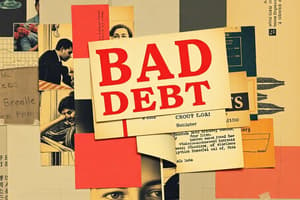Podcast
Questions and Answers
What is the direct write-off method used for in accounting?
What is the direct write-off method used for in accounting?
- To account for bad debts when the amount is immaterial (correct)
- To evaluate accounts receivable
- To record accounts payable
- To account for bad debts when the amount is material
What is the alternative method to the direct write-off method in accounting for bad debts?
What is the alternative method to the direct write-off method in accounting for bad debts?
- The allowance method (correct)
- The accounts receivable method
- The accounts payable method
- The bad debts expense method
What is the term used to describe an account that is only a few days late in payment?
What is the term used to describe an account that is only a few days late in payment?
- Past due
- Uncollectible
- Overdue (correct)
- Defaulted
What is the journal entry to record a write-off of a bad debt using the direct write-off method?
What is the journal entry to record a write-off of a bad debt using the direct write-off method?
At what point is an account considered past due or overdue?
At what point is an account considered past due or overdue?
What is the term used to describe an account that is unlikely to be paid by the customer?
What is the term used to describe an account that is unlikely to be paid by the customer?
What is the purpose of evaluating accounts receivable?
What is the purpose of evaluating accounts receivable?
What is the disadvantage of using the direct write-off method?
What is the disadvantage of using the direct write-off method?
What is the term used to describe the amount of money that is unlikely to be paid by customers?
What is the term used to describe the amount of money that is unlikely to be paid by customers?
Why is the direct write-off method simple?
Why is the direct write-off method simple?
Flashcards are hidden until you start studying
Study Notes
Estimating Bad Debts Expense
- There are two approaches to estimate bad debts expense using the allowance method:
- Percentage of Total Receivables method
- Percentage of sales method
Consequences of Not Paying Past Due Balance
- Consequences of not paying past due balance include:
- Phone calls from creditors or service providers
- Past due letters in the mail
- Discontinued service (in the case of utilities)
- Negative impact on credit score
- Legal action
Recording Customer Information
- Information is a fact, thought, or data conveyed through various types of communication
- Knowledge communicated or received concerning a particular fact or circumstance
Direct Write-Off Approach
- The direct write-off approach involves:
- Recording the write-off of an uncollectible account
- Debiting Uncollectible Accounts Expense and crediting Accounts Receivable
- Reducing the receivables balance for the item that is deemed uncollectible
Allowance Method
- The allowance method involves:
- Estimating doubtful debts made at the end of the period
- Making an adjusting entry at the end of each accounting period
- Recognizing the expense in the same period as the related revenue
- Creating an allowance that will be deducted from accounts receivable on the balance sheet
- Accounting for bad debts consistently with the principles of accrual accounting
Overdue Account Reporting System
- An overdue account is considered past due as soon as a payment is missed
- Even if only a few days late, the account is technically considered overdue
- The account may face collection efforts if payment is not made
Studying That Suits You
Use AI to generate personalized quizzes and flashcards to suit your learning preferences.



